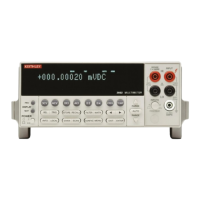IEEE-488 Reference
3-72
ACI), 1
Ω
on the ohms functions (
Ω
2 or
Ω
4), and 1° (C, F or K) for the temperature function
(TEMP). A limit value is not range sensitive. A limit of 2 for DCV is 2V on all measurement
ranges. Note that limit tests cannot be performed on frequency (FREQ) measurements.
PRINT #1, "output 16; :calc3:lim:upp 10; upp?" ' Set upper LIMIT 1 and query
PRINT #1, "enter 16" ' Get response message from
2002
:SOURce <NRf>
:CALCulate3:LIMit[1]:UPPer:SOURce <NRf> Specify pattern; upper LIMIT 1 failure
:CALCulate3:LIMit[1]:LOWer:SOURce <NRf> Specify pattern; lower LIMIT 1 failure
:CALCulate3:LIMit2:UPPer:SOURce <NRf> Specify pattern; upper LIMIT 2 failure
:CALCulate3:LIMit2:LOWer:SOURce <NRf> Specify pattern; lower LIMIT 2 failure
<NRf> = 0 to 15 Specify digital pattern for output port
:SOURce? Query source value for specified limit
These commands are used to specify which line(s) of the Digital Output Port will go true when
a limit test failure occurs. The first failure in the test sequence determines the digital output pat-
tern. Subsequent failures in the test sequence will not change the digital output pattern on the
output port.
Each output line is assigned a decimal weight as follows:
Digital Output Decimal Weight
Line #1 1
Line #2 2
Line #3 4
Line #4 8
The parameter value for the digital pattern is determined by adding the decimal weights of the
desired output lines. For example, if you want output lines #2 and #3 to go true when the upper
limit of LIMIT 1 is the first failure in the test sequence, use a parameter value of 6 (2+4).
The actual true state (high or low) of each Digital Output line depends on its programmed po-
larity. Polarity is programmed from the OUTPut subsystem (see paragraph 3.16).
Note that when the binning strobe is enabled (see :BSTRobe command path), output line #4 is
not considered to be part of the digital output pattern. The binning strobe uses line #4. With the
binning strobe enabled, parameters 8 through 15 are treated the same as parameters 0 through 7.
PRINT #1, "output 16; :calc3:lim:upp:sour 4; sour?" ' Select line #4 and query
PRINT #1, "enter 16" ' Get response message
from 2002
:STATe <b>
:CALCulate3:LIMit[1]:STATe <b> Control LIMIT 1 test
:CALCulate3:LIMit2:STATe <b> Control LIMIT 2 test
<b> = 1 or ON Enable specified limit test
0 or OFF Disable specified limit test
:STATe? Query state of specified limit test
Program fragment
Parameters
Query
Description
Program fragment
Parameters
Query

